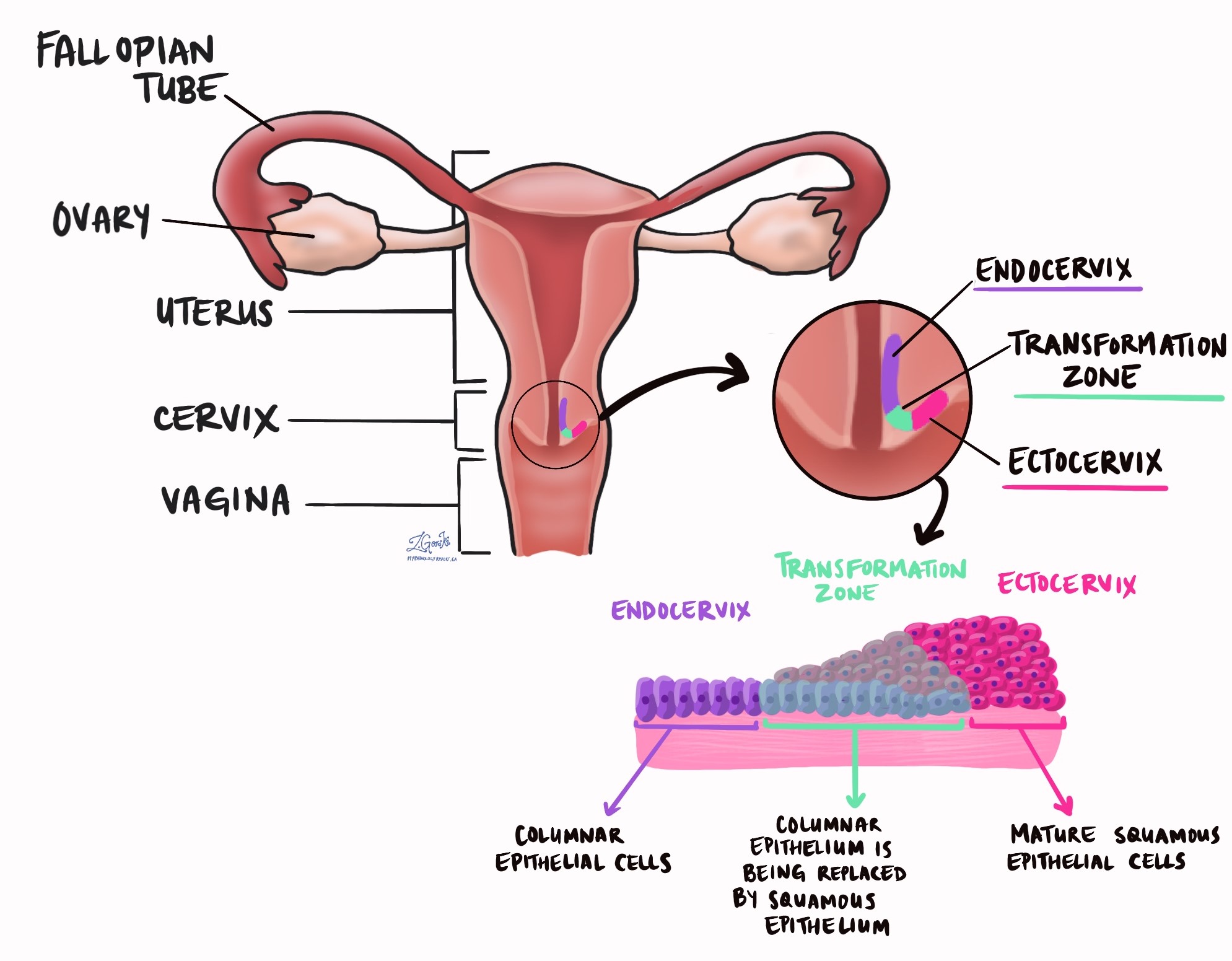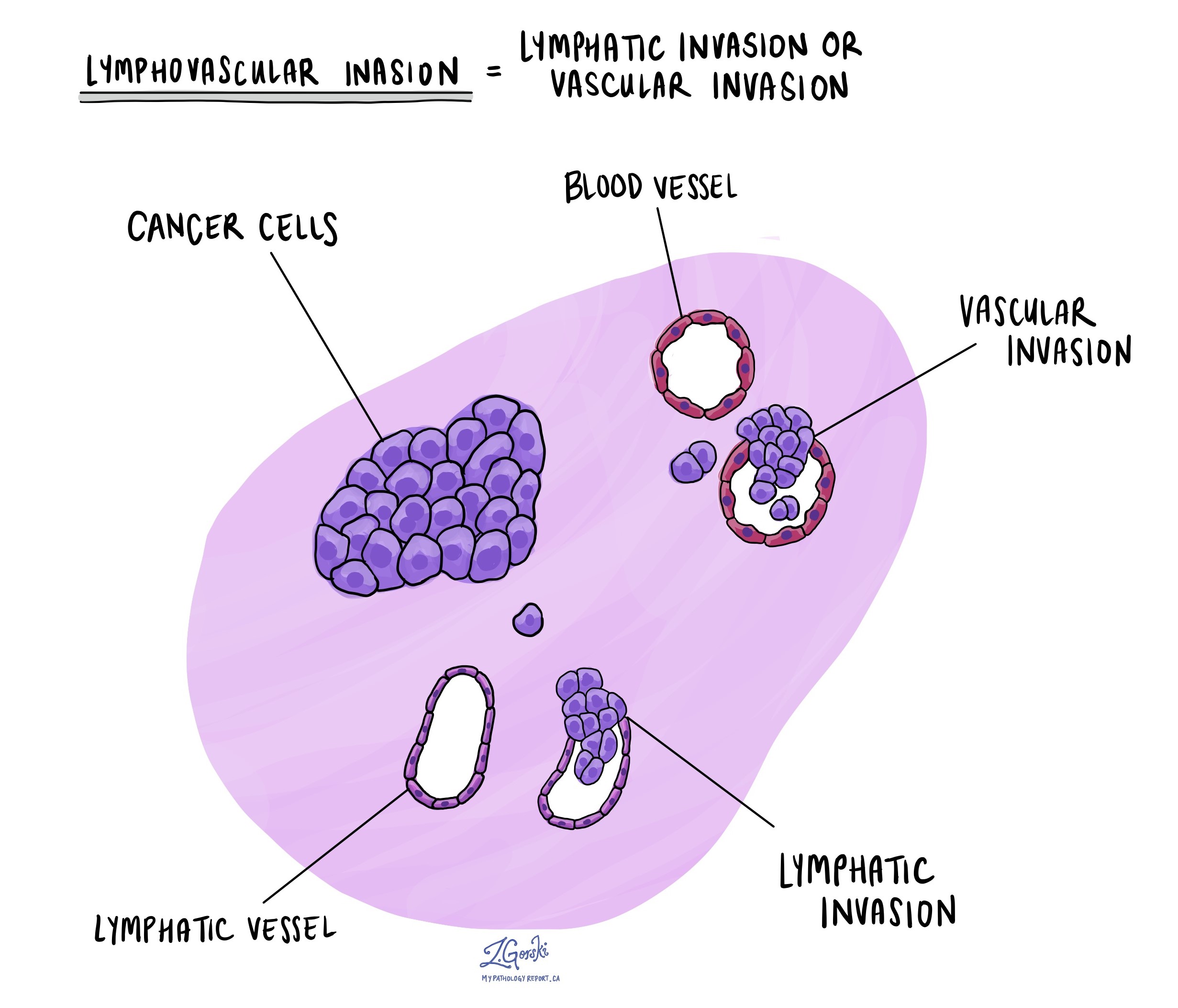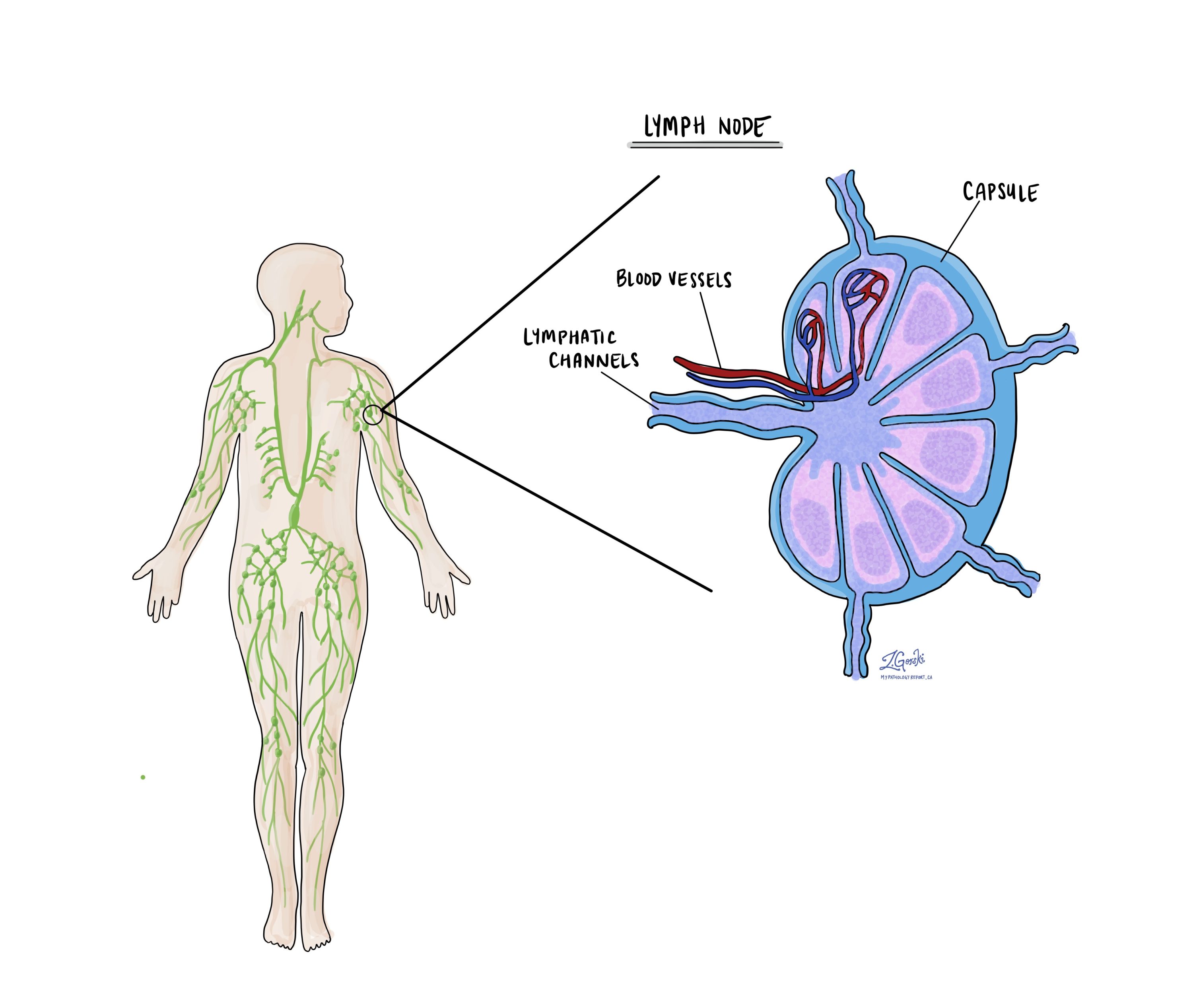by Jason Wasserman MD PhD FRCPC
December 14, 2023
Squamous cell carcinoma (SCC), also called invasive squamous cell carcinoma, is the most common type of cervical cancer. The tumour starts from squamous cells normally found in the epithelium on the outside surface of the cervix.
SCC of the cervix can be keratinizing (KSCC), non-keratinizing (NKSCC), or basaloid. Keratinizing means that the tumour cells are making a protein called keratin. Non-keratinizing means the tumour cells are not making keratin. Basaloid means that the tumour cells resemble the basal cells normally found at the base of the epithelium. Despite these differences, all three subtypes show similar behaviour and prognosis.
What causes squamous cell carcinoma in the cervix?
The most common cause of SCC of the cervix is infection with a sexually transmitted virus called human papillomavirus (HPV). The virus infects cells in an area of the cervix called the transformation zone. HPV is divided into types and twelve types (16, 18, 31, 33, 35, 39, 45, 51, 52, 56, 58, and 59) are responsible for more than 90% of all cases of SCC in the cervix. Tumours caused by HPV are called HPV-associated, those that are not are called HPV-independent.

What are the symptoms of squamous cell carcinoma of the cervix?
Small tumours typically do not cause any symptoms and the tumour is discovered when a screening Pap smear is performed. Symptoms associated with larger tumours include abnormal vaginal bleeding, discharge, and pain.
Your pathology report for squamous cell carcinoma of the cervix
The information found in your pathology report for SCC of the cervix will depend on the procedure performed. For small procedures such as a Pap smear, your report may only include the diagnosis. A biopsy report may also include the tumour grade and immunohistochemistry may be performed to look for p16 in the tumour cells. For larger procedures such as an excision or resection performed to remove the entire tumour, additional information such as the size of the tumour, depth of invasion, and the assessment of margins may also be described. Please see the sections below for more details.
What does it mean if squamous cell carcinoma of the cervix is described as well, moderately, or poorly differentiated?
Pathologists divide SCC of the cervix into three grades – well, moderately, and poorly differentiated – based on how much the tumour cells look like normal squamous cells when examined under the microscope. The grade is important because higher-grade tumours (for example poorly differentiated tumours) behave more aggressively and are more likely to metastasize (spread) to other parts of the body.
SCC of the cervix is graded as follows:
- Well differentiated SCC of the cervix (grade 1) – Well differentiated SCC of the cervix is made up of tumour cells that look almost the same as normal squamous cells.
- Moderately differentiated SCC of the cervix (grade 2) – Moderately differentiated SCC of the cervix is made up of tumour cells that look different from normal squamous cells, however, they can still be recognized as squamous cells.
- Poorly differentiated SCC of the cervix (grade 3) – Poorly differentiated SCC of the cervix is made up of tumour cells that look very little like normal squamous cells. These cells can look so abnormal that your pathologist may need to order an additional test such as immunohistochemistry to confirm the diagnosis. These tumours tend to behave in a very aggressive manner and are associated with worse prognosis compared to well and moderately differentiated tumours.
How do pathologists determine the tumour size for squamous cell carcinoma of the cervix and why is it important?
After the tumour has been surgically removed, it will be measured in three dimensions – length, width, and depth of invasion. Tumours with a depth of invasion greater than 5 mm and a width greater than 7 mm are more like to metastasize (spread) to other parts of the body such as lymph nodes. These measurements are also used to determine the pathologic tumour stage (pT).
- Length – The tumour is measured from top to bottom.
- Width – The tumour is measured from side to side.
- Depth of invasion – The tumour is measured from the epithelium on the surface of the cervix to the cancer cells at the very deepest point of invasion.
What does tumour extension mean and why is it important?
Tumour extension describes the distance the cancer cells have spread from where the tumour started in the cervix. Large tumours can grow beyond the cervix to involve surrounding organs and tissues such as the parametrium, endometrium, vagina, bladder, and rectum. If any of these tissues are removed, they will carefully be examined for cancer cells.
Your pathologist can only determine the amount of tumour extension after the entire tumour has been removed. It will not be described in your report after a Pap smear or a biopsy. Tumour extension into the parametrium or other organs around the cervix is associated with a worse prognosis and is used to determine the pathologic tumour stage (pT).
What does stromal invasion mean and why is it important?
The tissue that covers the inside surface of the cervix is called the epithelium while the tissue just below the epithelium is called the stroma. SCC of the cervix starts in the epithelium but as the tumour grows, the cells spread into the stroma. This is called stromal invasion. The amount of stromal invasion is not the same as the tumour size because the tumour size also includes any HSIL that may be above the area of invasion. For that reason, the size of the tumour may be larger than the amount of the stromal invasion.
Most pathology reports will describe the amount of stromal invasion in two directions:
- Depth of invasion – This is the amount of invasion measured from the surface of the tumour to the deepest point of invasion.
- Horizontal extent of invasion – This is the amount of invasion measured from one side of the tumour to the other.
The amount of stromal invasion is important because it is used to determine the pathologic tumour stage (pT). In general, less stromal invasion is associated with a better prognosis while more invasion is associated with a worse prognosis.
What does lymphovascular invasion mean and why is it important?
Lymphovascular invasion means that cancer cells were found inside a blood vessel or lymphatic vessel. Blood vessels are long thin tubes that carry blood around the body. Lymphatic vessels are similar to small blood vessels except that they carry a fluid called lymph instead of blood. The lymphatic vessels connect with small immune organs called lymph nodes that are found throughout the body. Lymphovascular invasion is important because cancer cells can use blood vessels or lymphatic vessels to spread to other parts of the body such as lymph nodes or the lungs. If lymphovascular invasion is seen, it will be included in your report.

What is a margin and why are margins important?
A margin is any tissue that has to be cut by the surgeon to remove the tumour from your body. If you underwent a surgical procedure to remove the entire tumour from your body, your pathologist will examine the margin closely to make sure there are no cancer cells at the cut edge of the tissue.
A margin is called negative if there are no cancer cells at the cut edge of the tissue. In contrast, a margin is considered positive when the cancer cells are seen at the edge of the cut tissue. If HSIL is seen at the margin that will also be described in your report. Finding cancer cells at the margin increases the risk that the tumour will grow back in that location.
The number and type of margins described in your report will depend on the type of procedure performed to remove the tumour from your body. Pap smears do not have margins.
Common margins include:
- Endocervical margin – This is where the cervix meets the inside of the uterus.
- Ectocervical margin – This is the bottom of the cervix, closest to the vagina.
- Deep margin – This is the tissue inside the wall of the cervix.
- Radial margin – This is the soft tissue that surrounds the cervix. The radial margin will only be described in your report if you had your entire cervix and uterus removed at the same time.

What are lymph nodes and why are they important?
Lymph nodes are small immune organs found throughout the body. Cancer cells can spread from a tumour to lymph nodes through small vessels called lymphatics. Lymph nodes are not always removed at the same time as the tumour. However, when lymph nodes are removed, they will be examined under a microscope and the results will be described in your report.

Cancer cells typically spread first to lymph nodes close to the tumour although lymph nodes far away from the tumour can also be involved. For this reason, the first lymph nodes removed are usually close to the tumour. Lymph nodes further away from the tumour are only typically removed if they are enlarged and there is a high clinical suspicion that there may be cancer cells in the lymph node. Most reports will include the total number of lymph nodes examined, where in the body the lymph nodes were found, and the number (if any) that contain cancer cells. A group of cancer cells in a lymph node is called a metastasis or metastatic deposit. For squamous cell carcinoma of the cervix, the size of the metastasis will also be measured as follows:
- Isolated tumour cells – The area inside the lymph node with cancer cells is less than 0.2 millimetres in size.
- Micrometastases – The area inside the lymph node with cancer cells is more than 0.2 millimetres but less than 2 millimetres in size.
- Macrometastases – The area inside the lymph node with cancer cells is more than 2 millimetres in size.
The examination of lymph nodes is important for two reasons. First, this information determines the pathologic nodal stage (pN). Second, finding cancer cells in a lymph node increases the risk that cancer cells will be found in other parts of the body in the future. As a result, your doctor will use this information when deciding if additional treatment such as chemotherapy, radiation therapy, or immunotherapy is required.
What does it mean if a lymph node is described as positive?
Pathologists often use the term “positive” to describe a lymph node that contains cancer cells. For example, a lymph node that contains cancer cells may be called “positive for malignancy” or “positive for metastatic carcinoma”.
What does it mean if a lymph node is described as negative?
Pathologists often use the term “negative” to describe a lymph node that does not contain any cancer cells. For example, a lymph node that does not contain cancer cells may be called “negative for malignancy” or “negative for metastatic carcinoma”.
What information is used to determine the pathologic stage (pTNM)?
The pathologic stage for SCC of the cervix is based on the TNM staging system, an internationally recognized system created by the American Joint Committee on Cancer. This system uses information about the primary tumour (T), lymph nodes (N), and distant metastatic disease (M) to determine the complete pathologic stage (pTNM). Your pathologist will examine the tissue submitted and give each part a number. In general, a higher number means a more advanced disease and a worse prognosis.
Tumour stage (pT)
The pathologic tumour stage for SCC of the cervix is based on three factors: the amount of stromal invasion, the size of the tumour, and the extension of the tumour into surrounding organs or tissues.
- T1a – Tumours in this category were found only after the tissue was examined under the microscope. These tumours also have a depth of invasion that is 5 millimetres or less AND and a horizontal spread that is 7 millimetres or less.
- T1b – Your doctor saw the tumour during your physical examination OR the depth of invasion is greater than 5 millimetres OR the horizontal spread is greater than 7 millimetres.
- T2a – The tumour extends outside of the uterus but not into the parametrium.
- T2b – The tumour extends into the parametrium.
- T3a – The tumour extends to the lower part of the vagina.
- T3b – The tumour extends into the wall of the pelvis OR the tumour has caused injury to the kidney.
- T4 – The tumour extends into the bladder or rectum OR the tumour extends outside of the pelvis into the abdomen.
Nodal stage (pN)
The pathologic nodal stage (pN) is based on the examination of lymph nodes for cancer cells.
- NX – No lymph nodes were sent to pathology for examination.
- N0 – No cancer cells were found in any of the lymph nodes examined.
- N0(i+) – Only isolated cancer cells were found in a lymph node.
- N1 – A group of cancer cells larger than 0.2 millimetres was found in at least one lymph node.
Metastatic stage (pM)
SCC is given a metastatic stage of 0 or 1 based on the presence of cancer cells at a distant site in the body (for example the lungs). The metastatic stage can only be determined if tissue from a distant site is submitted for pathological examination. Because this tissue is rarely present, the metastatic stage cannot be determined and is listed as pMX.
About this article
This article was written by doctors to help you read and understand your pathology report. Contact us if you have any questions about this article or your pathology report. Read this article for a more general introduction to the parts of a typical pathology report.


